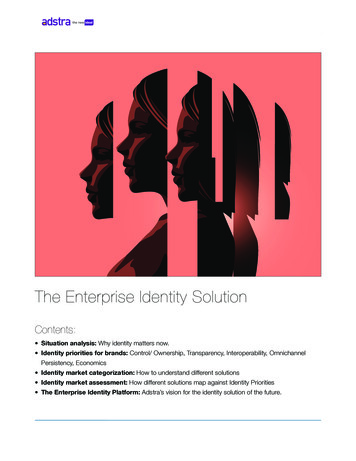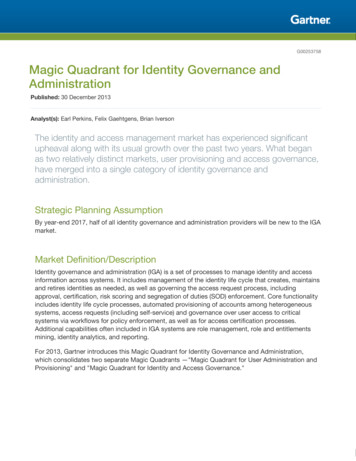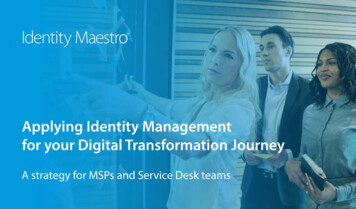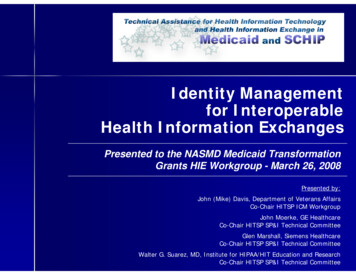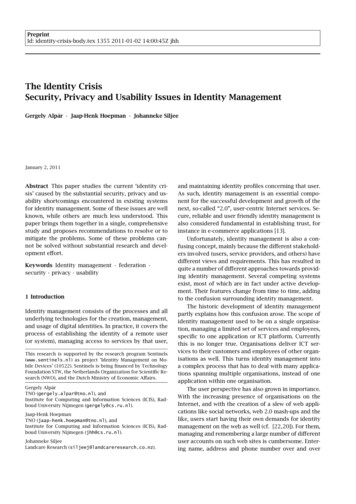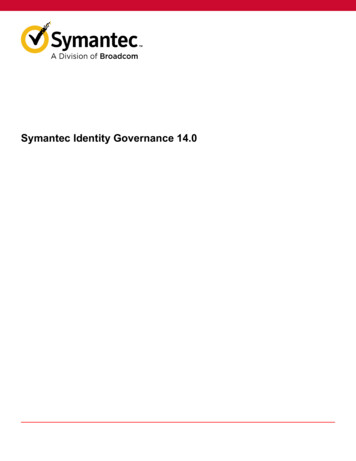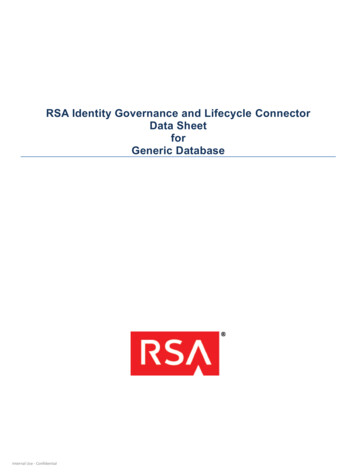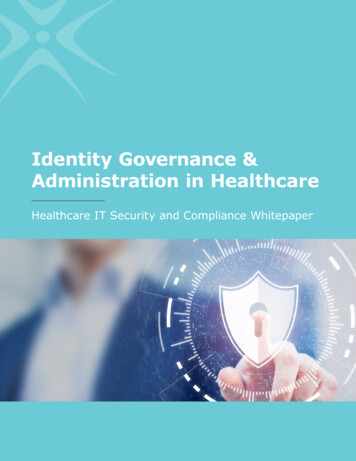
Transcription
Identity Governance &Administration in HealthcareHealthcare IT Security and Compliance Whitepaper
Table of ContentsExecutive Summary. . . . . . . . . . . . . . . . . . . . . . . . . . . . . . . . . . . . . . . . . . 2What is Identity Governance and Administration? . . . . . . . . . . . . . . . . . . . . . 2History Behind the Powerful Benefits & Impressive Growth . . . . . . . . . . . . . . 3Identity Governance and Administration Timeline . . . . . . . . . . . . . . . . . . . . . 3Benefits of Identity Governance and Administration. . . . . . . . . . . . . . . . . . . . 4Why is Identity Governance and Administration Growing in Healthcare?. . . . . . 5How Should Organizations Determine the Best Approach? . . . . . . . . . . . . . . . 7Case Studies for Identity Governance Success . . . . . . . . . . . . . . . . . . . . . . . 10Scenario 1: Quickly Onboarding New Users at New Facilities . . . . . . . 10Scenario 2: Standardize Processes and Policies. . . . . . . . . . . . . . . . .11Scenario 3: User-Access Reviews . . . . . . . . . . . . . . . . . . . . . . . . . . 11Scenario 4: Unstructured Data Access. . . . . . . . . . . . . . . . . . . . . . . 12Scenario 5: Adopting a Cybersecurity Framework. . . . . . . . . . . . . . . 12Scenario 6: New-Hire Access on Day One . . . . . . . . . . . . . . . . . . . . 12Select a Solution. . . . . . . . . . . . . . . . . . . . . . . . . . . . . . . . . . . . . . . . . . . . 13Conclusion. . . . . . . . . . . . . . . . . . . . . . . . . . . . . . . . . . . . . . . . . . . . . . . . 14Key Takeaways: . . . . . . . . . . . . . . . . . . . . . . . . . . . . . . . . . . . . . . 141
Identity Governance & Administration in HealthcareExecutive SummaryThis whitepaper is designed as a resource to assist readers in getting started ontheir identity governance and administration (IGA) journey. There are importantquestions to ask and factors to weigh before even beginning to consider a softwaresolution. Learn what IGA means, why it is important and what organizations shouldplan for, understand and anticipate to ensure the selection of the right combinationof solutions and services for end users and specific environments.What is Identity Governance and Administration?Identity governance and administration is commonly known as centralized visibilityof identity management and access controls. These controls should be policy-basedand support overall security, regulatory compliance and auditing practices. IGAprovides lifecycle management of digital identities, promoting consistent businessprocesses for reviewing, requesting, approving/revoking access and managingpasswords, underpinned by a common policy, role and risk model.Policy-based centralizedorchestration of user identitymanagement and access controlSupports enterprise IT securityand regulatory complianceEnables and securesdigital identities for all users,applications and dataIGA provides healthcare organizations with powerful benefits and has adaptedaccordingly to the industry’s cloud-based demands. IGA provides a central locationto enable and secure digital identities for all users, applications and data. In anutshell, it enables the right individuals to access the right resources at the righttimes for the right reasons.2
Identity Governance & Administration in HealthcareHistory Behind the Powerful Benefits &Impressive GrowthThere’s no doubt about it, IGA is here to stay. IGA is growing at an impressiverate, and changes in the healthcare industry continue to feed this upward trend.It emerged as a new category of identity management driven by mandates andregulatory requirements like Sarbanes-Oxley Act (SOX) and Health InsurancePortability and Accountability Act (HIPAA) meant to improve transparency andmanageability. In fact, IGA was recognized by Gartner as the fastest-growingsector of the identity management market back in 2012 and has continuedan upward trend since. That year, Gartner also stated that identity governance“is replacing user administration and provisioning as the new center of gravityfor IGA.”2Originally predicted to grow at 35-40% per year, it grew to a 3.04 billion marketin 2018. Several factors contributed to IGA’s growth, including increases in insidertheft and fraud, regulations regarding the security of protected health information(PHI), and frequently changing roles and locations of providers and support staff.Identity Governance and Administration TimelineEmerged as a new categoryof identity management drivenby the requirements of newregulatory mandates suchas the Sarbanes-Oxley Actand HIPAA.Gartner stated that identitygovernance “is replacinguser administration andprovisioning as the newcenter of gravity for IGA.”Recognized by Gartner as thefastest-growing sector of theidentity management marketin 2012.Gartner estimated growthrates would exceed 35-40%per year, based on increasedincidences of insider theftand fraud.2 Earl Perkins, Gartner Magic Quadrant for Identity and Access Governance, (2012).3
Identity Governance & Administration in HealthcareBenefits of Identity Governanceand AdministrationIGA empowers organizations to grant end users the access needed to be up andrunning more efficiently, while also expediting user deprovisioning in the eventof end-user departure or termination. This saves valuable time for departmentslike HR and, especially, IT and reduces the time it takes to grant new employeesaccess to critical systems by eliminating manual provisioning processes that inthe past may have caused delays of days or weeks. IGA reduces IT staff workloadby providing a centralized, streamlined location for user identity and accessmanagement - in both cloud-based and data center scenarios. Not only is securityenhanced, but improved reporting protects organizations from non-compliance withindustry regulations.StrengthensSecurityDeliver Fast &Efficient AccessWhocurrentlyhas access?ReduceOperational CostsIdentityHowis accessGovernancebeing used?Improve ProductivityWhoshouldImproveAudit Performancehave access?Improve ComplianceOther benefits of identity governance and administration: Delivers efficient access to business users, empowering them to requestaccess and manage passwords Reduces operational costs by automating access certifications andrequests, password management and provisioning Reduces IT staff workload4
Identity Governance & Administration in HealthcareWhy is Identity Governance and AdministrationGrowing in Healthcare?The HIMSS 2019 Cybersecurity Survey shows that “a pattern of cybersecuritythreats and experiences is discernable across US healthcare organizations.”Furthermore, the survey states that “almost half (48%) of all respondents cited twoprimary threat actors; online scam artists (28%) and negligent insiders (20%).”2Healthcare Breaches by Threat Actors3Verizon 2020 Data Breach Investigations Insider breaches, as these statistics simply outline, continue to force identitygovernance into the forefront of a security strategy in healthcare just like it hasin other industries like financial, energy and government. Additionally, healthcareproviders and staff are more mobile than ever – frequently changing locations androles. These factors, combined with the requirements of regulatory mandates (suchas the Sarbanes-Oxley Act and HIPAA), present a clear need for IGA in healthcare.“As with hacking, healthcare organizations are getting better at detectinginternal breaches and reporting those breaches to the Office for Civil Rights.These incidents consist of errors by employees, negligence and acts bymalicious insiders.”32 HIMSS Cybersecurity Survey, (Healthcare Information and Management Systems Society, 2019), 3 & 6.3 2020 Data Breach Investigation Report, (Verizon, 2020), 56.5
Identity Governance & Administration in Healthcare HIPAA Journal 2020 HIPAA Journal 20204 Healthcare Data Breach Statistics, (HIPAA Journal, 2020).446
Identity Governance & Administration in HealthcareHow Should Organizations Determine theBest Approach?While fully embracing the tenets of identity governance can result in true businesstransformation, organizations often want to approach IGA as a short-term technicalproject. The best approach is to plan for the long-term, to consider a fullyintegrated approach that is continually optimized as it matures, while tackling highvalue, clear-vision projects that rapidly provide business value.It is important to prepare at the leadership level to support managers and staffwith implementing and supporting an IGA solution. The following are a few goodquestions to ask before embarking on an identity project that requires the crossdepartmental cooperation and execution of identity governance.Is there anidentity strategy? Focus on the future Guidance foremployees Ownership andaccountabilityIs the current culturesupportive of thestrategy? Culture definesbehavior Culture defines whatis important Culture complementsstrategyAre there people toexecute and maintainthe strategy? Invest in the rightteam (skills andheadcount) Alignment withthe cultureWhile alignment of strategy and culture are important goals of any organization,there are levels of development and maturity to any strategy. On the next page isa detailed graphic outlining a sample plan for achieving an “optimized” level. Eachlevel builds on the next to grow and maintain a successful IGA strategy.7
Identity Governance & Administration in HealthcareLevel 1InitialLevel 2DevelopingTactical priorities setbased on certainbusiness driversGovernance isisGovernancead hochoc ancyredundancyis likelylikelyisTools put in placeTools put in placeon a piecemealona piecemealbasisbasisAn IGA structureis definedgovernancestructure isdefinedLevel 4ManagedMultiyear projectsMulti-yearprojectsarearealigned with vision andstrategyIGA performancetargets areactualizedDiscrete technologyDiscreteprojects technologyprojectsLevel 5OptimizedPerformance iscontinuously monitoredTransformationalvalueThe IGAIGA PMOPMOTheis establishedestablishedisIGA architectureIGA architecturealigned with EAaligned with EABusiness value isBusinesstactical value istacticalResponsibilities areResponsibilitiespoorly defined arepoorly definedLevel 3DefinedAn IGAAnIGAarchitecturearchitectureis definedis definedAn IGA vision isAnIGA vision isdefineddefinedKey stakeholdersKeystakeholdersare activelyinvolvedareactivelyinvolvedin IGAprogramin IGA programThe IGA program isThe IGA program isdynamic and adaptivedynamic and adaptiveto changes businessto changes businessconditionsconditionsAfterOnce anyou’ve"optimizedreached anstatus"is“optimizedreached,rinse&status," rinseandrepeatrepeatthetheprocess.process.ThisThis allowsallows thethere-alignmentre-alignment ofofpriorities andstrategiesstrategy asastheyourIGAIGAvisionvisionadaptsadapts withwith thethebusiness.businessUpon reaching an optimized level of maturity, organizations will most likelyhave a shift in strategy, whether big or small. As with all businesses, healthcareorganizations must adjust their business to align with such things as acquisitions,recessions, demographic changes, new technologies, and - unique to healthcare medical treatment options, illness trends and changing regulations. It's importantto continually realign the IGA vision and business strategy to ensure organizationalsecurity now and in the future.However, IGA is not a one-size-fits-all solution. The starting point for an IGAstrategy will vary and should be developed around the unique requirements andobjectives of the organization. The approach of a 200-facility organization withover 10,000 employees operating in multiple states will have fundamentallydifferent goals than the approach of a community hospital with one affiliatedphysician practice. It’s also very important to recognize that IGA is not onedestination or one project, it is a journey or program with risks that are specificto the business. A good tenet of a successful IGA strategy is to ensure a facility'soverall security is stronger than it was before the program began.8
Identity Governance & Administration in HealthcareHere are some quick tips for moving up the levels on thechart from page 8:1. Establish an IAM/IGA team. This is a long-term team that will handlethe short-term projects as well as changes in ongoing identity strategyto ensure alignment with the organization’s business strategy. They areaccountable to the leadership team but are also responsible for maintainingthe day-to-day needs of any software and hardware solutions needed tosupport the identity strategy.2. Identify the most immediate risk and tackle it quickly: This willkeep decision makers engaged and show them quick time to value.As mentioned previously, the true benefit is the long-term, but if theleadership team becomes disillusioned or impatient with the program, itcould stall. Tackle some short-term projects to show the value of identitygovernance while building toward optimization.3. Staff appropriately. Don’t underestimate the effort required for mostorganizations to work through the levels of optimization. Tackling theidentification of roles, such as nursing, can be overwhelming when viewingHR's list of job descriptions. However, there are best practices and lessonslearned available from other healthcare IT professionals, consultants,security firms, continuing education, forums, whitepapers, industry expertsand more. Starting from ground zero is not necessary. Reach out to othersto see what has worked, but keep in mind that a support team for theproject and organization is essential to mitigate risk.4. Decision making is cross-departmental. While IT will most likely ownidentity governance, it is important to relay value and understand the ROIfrom other departments early in the process. HR, Operations, Compliance,along with varied departments within IT, are often integral to the decisionmaking process.9
Identity Governance & Administration in Healthcare5. IGA impacts all departments. It can be a transformative part ofrolling out an IGA strategy to transfer access audits to managers,instead of having it sit with IT and department heads. Involve allaffected departments on how process changes will affect them. Again,communicating process changes early, especially how auditing will beperformed, is integral for mitigating the risk of assigning access to thewrong users.Case Studies for Identity Governance SuccessAlthough IGA initiatives can have the perception of long timelines and high costs,the benefits can far outweigh the challenges. Review the use cases below to seereal-world applications and benefits.Scenario 1: Quickly Onboarding New Users at New FacilitiesHandling the volume of new users as new ambulatory facilities are acquiredcan be a challenge for many healthcare IT departments at healthcareorganizations. Granting the right access to mission-critical applicationsand ensuring user have the correct access as they move through multipledepartments and locations at different times is a challenge when usingmanual processes.Implementing a comprehensive identity governance andadministration platform: Reduces time to provision new user accounts with automatedprocesses Provides the right access to users moving among multiple locations Reduces risk of a security breach brought on by giving the wrongaccess to the wrong person Reduces the administration burden for IT staff10
Identity Governance & Administration in HealthcareScenario 2: Standardize Processes and PoliciesMany healthcare organizations have no standard approach for creating andprovisioning user accounts. Employees responsible for this function may usetheir own method during their shift and don’t share or cross-train, especiallyat smaller facilities where only 2-3 employees are handling these duties.Often, important components are left out during account creation or errorsare made in the pursuit of expediting the user’s access. There is also a risk ofinconsistent terminology usage for naming roles, departments or locations.Rolling out a new identity governance and administration solution: Helps reduce errors and inconsistencies Standardizes the approach for account creation Simplifies provisioning across the health system Reduces the risk of an audit failure or non-complianceScenario 3: User-Access ReviewsHospitals often use manual processes to perform user-access reviews andaudits by exporting data from multiple applications into spreadsheets. Often,these spreadsheets are then printed out and hand-walked to departmentheads for review and signatures, sitting on desks until the busy leadershipteam members have time to review and pass to the next person. There is noway to effectively manage this process or ensure spreadsheets were reviewedin a timely manner.Implementing an identity governance and administration solution can: Automate this process Improve accountability with audit scheduling11
Identity Governance & Administration in HealthcareScenario 4: Unstructured Data AccessData Loss Prevention (DLP) can be a substantial problem for some hospitalsand it can be difficult to uncover granular-level details about that data.Specifically, where the data is, whether it’s active, where the sensitive data is(and how it’s accessed and if permissions are used).There are solutions that can protect and combat “data on the move”that include: Access permissions Methods for discovering and classifying sensitive data Monitoring file accessScenario 5: Adopting a Cybersecurity FrameworkSecurity frameworks, like NIST or HITRUST, are a badge of honor forhospitals and their IT leadership, and they lower cyber security insurancepremiums. Some organizations struggle to check off all the boxes requiredfor compliance. However, identity governance can help achieve a complianceframework that meets the necessary regulatory requirements, specifically: Access certifications SOD policies Protecting access to unstructured dataScenario 6: New-Hire Access on Day OneOn day one newly hired doctors and nurses need access to their criticalsystems and applications. Often, IT departments have few staff managingthe provisioning of many identities and, subsequently, far too much paper.New hires get bogged down with forms to be completed, and subsequentaccess requests are also filled out manually via paper and walked to theappropriate person.12
Identity Governance & Administration in HealthcareWith an identity governance and administration strategy: Accounts are automatically provisioned Access requests are conveniently and quickly completed via anonline portalSelect a SolutionAs mentioned previously, IGA is not a one-size-fits-all solution. There are manyindustry players with various strengths and weaknesses, but there are commonproduct features that should be a part of any solution. These rationAuditingand AnalyticsQuestions to ask when choosing an IGA solution include: What is the primary objective/issue to address? Beyond employees, what other types of users are included? Customers? Vendors? Contractors/consultants? What is the covered environment? Physical data centers/virtual machines? Cloud-based assets? Mobile devices? How many identities need to be secured? How will it be managed – internally, externally or a combination? Cloud-based SaaS vs. on-premises solution? How well does it integrate?13
Identity Governance & Administration in HealthcareConclusionBecause of the value of its identities, the healthcare industry is particularlyvulnerable to cybersecurity threats, as well as insider threats. In fact, Forbes hasestimated that 58% of all healthcare breaches are initiated by insiders. That’s asobering statistic. The good news is that IGA has the power to enhance onboardingwhile improving security, reportability, and user identity management – all from acentralized location. No two organizations are the same, including their EHR, otherclinical systems, HR process, network, user communities, company culture, datalocations, access methods, etc. Project leaders should plan early and ask the rightquestions about their organization's technical environment but also its readinessand strategy for long-term execution.Key Takeaways: Start planning now Assess organizational readiness Assess the technical environment Prioritize requirements for a solution and services Continue to optimize14
Identity Governance & Administration in HealthcareWhy Forward Advantage?Forward Advantage has 25 years of experience in the healthcare industry,working with a variety of EHRs and as a MEDITECH-preferred partner. We offerindustry-leading IGA solutions and help each hospital build its own unique strategybased on user communities and environment. It’s never too early to start planningfor an identity governance program. Contact us for help evaluating your currentenvironment and existing strategies to ensure an IGA solution that fits your needsnow and long into the ght 2021 Forward Advantage, Inc. All rights reserved.www.forwardadvantage.com7255 N. First Street, Suite 106, Fresno, CA 937202021IGA01WP2515
2 Earl Perkins, Gartner Magic Quadrant for Identity and Access Governance, (2012) . Emerged as a new category of identity management driven by the requirements of new regulatory mandates such as the Sarbanes-Oxley Act and HIPAA. Gartner stated that identity governance "is replacing user administration and provisioning as the new

